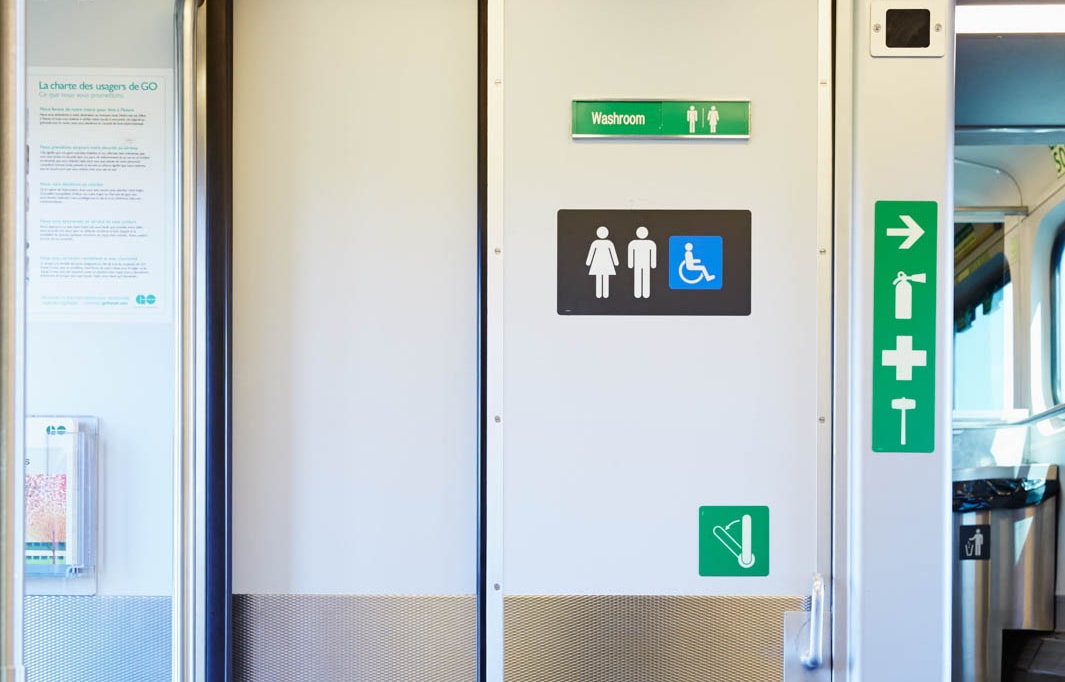Going on the GO - Diving deep into the toilets on our trains
What happens to all that human waste after it’s flushed away aboard GO trains? We show you.
Dec 10, 2019
Update: Need to find washrooms on GO trains and buses? Read our latest article for all the details.
It can be the best seat on a GO train.
A throne away from home.
And – even in the middle of a trip aboard a GO Transit train – a pause to appreciate the privacy you’re in.
Every year, GO records more than 56 million passenger trips. And every one of those customers – no matter how different their reasons for travelling with us or where they are headed – have something in common. We all have to go to the bathroom.
But what happens to all the bodily waste that’s collected aboard GO train toilets, and who makes sure those small cubicles are welcoming retreats?
Private quarters. A toilet waits patiently to offer GO customers some needed privacy. (Metrolinx photo)
We’ve jumped in for answers.
Historically, commuter train lavatories would use toilets that drain straight onto the track, through a chute at the bottom of the toilet.
This was known as a ‘hopper toilet’. They ranged from a hole in the floor to a drop chute toilet and are still used in many parts of the world today, especially on older trains.
The next iteration of the train toilet system had a holding tank with what was perhaps uncomfortably known as a ‘pinch valve’, which would open when the vehicle hit 25mph, to dump the contents directly onto the tracks.
Both these systems are considered unhygienic and dangerous to health and the environment – littering railway corridors. Although GO transit never used these systems, the history brought us to where we are today.
When customers use the bathroom on our newer coaches, it all goes in a chemical holding tank – or a ‘retention tank’.
Flush with success – The blue chemical that keeps things in order. No need to check – we already did – it has a nice, cherry smell. (Metrolinx photo)
And what about the smell? The toilets are flushed with a blue chemical that has a cherry scent.
GO Transit estimates an annual usage of 1.2 million litres of the blue stuff from all fleets. If you were to put it all in one spot, it would amount to a small lake about 29.4 metres by 21.3 metres and about 4.3 metres deep.
There are two different products, one for summer and one for winter.
The products are identical except for the addition of an agent that does not freeze in the winter since the toilet tank is not insulated and would otherwise turn to icky ice.
The chemical holding, or retention tanks, are usually included on newer carriages but some of the refurbished coaches are equipped with a vacuum type toilet. Those are the same type and style as on an aircraft.
The tanks are monitored and regularly emptied as GO trains cycle through the maintenance shops for toilet servicing. The fresh chemical tanks hold almost 91 litres each and are behind a wall in the newer coaches. In classic coaches, they are up in the compartment above the washroom.
The waste tank can hold 205 litres and is located under the train car.
It usually takes two people to work on the draining process. Here, a drain hose is inserted into the tank. It takes about 2-3 hours to empty the waste tanks. (Metrolinx photo)
This makes for easy access as the waste is directly emptied to the municipal sewers at the Willowbrook Rail Maintenance Facility.
To drain the tanks, the process is pretty straight forward. Crews remove the waste drain cap, insert a drain hose and open the valve.
Once the coach is drained, crews also take the time to replenish the blue, scented chemical that the toilet releases. This is called the ‘charging’ process and an indicator on the side of the washroom will let washroom cleaning crews, the same people who do a stellar job insuring those washrooms are kept pristine, know if the levels are low.
The draining and charging of the trains are generally performed every two weeks. Coaches are inspected for waste and chemical levels every day. If a coach requires draining and charging on short notice, the process can be performed in the yard thanks to a tractor and trailer with drain and fill capabilities. Once the trailer is full, it’s drained into the train shop’s system.
For most GO customers, moments spent inside one of the train toilets are stop and go, and not much afterthought. But for the transit agency, it takes time and dedicated teams of experts – including professional cleaners – to turn the bathrooms into rail retreats.
Which is to say, when you have to go on GO, we’re behind you all the way.
by Nitish Bissonauth Metrolinx bilingual editorial content advisor
